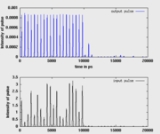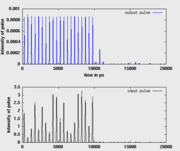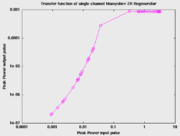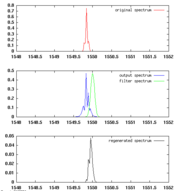
Mamyshev 2R regenerator
Encyclopedia
The Mamyshev 2R regenerator is an all-optical regenerator
used in optical communications.
In 1998, Pavel V. Mamyshev of Bell Labs
proposed and patented the use of the self-phase modulation
(SPM) for
single channel optical pulse reshaping and re-amplification.
(HP-EDFA) boosts the incoming signal to the power (Pm) required for optimal peak power equalization of the ‘one’ symbols. This amplifier can be followed by an optical bandpass filter (not shown in the figure) in order to reject out of band amplified spontaneous emission
.
The self-phase modulation
-induced spectral broadening is generated in a single-mode optical fiber
with a length . The chromatic dispersion
. The chromatic dispersion
of this fiber is normal and its value is D. The nonlinear coefficient is , and the linear losses are
, and the linear losses are  . Several types of fibers have been successfully tested : non-zero dispersion-shifted fibers, highly nonlinear silica fibers, microstructured silica fibers
. Several types of fibers have been successfully tested : non-zero dispersion-shifted fibers, highly nonlinear silica fibers, microstructured silica fibers
, chalcogenide fibers or tellurite fibers.
At the fiber output, an optical bandpass filter (OBPF) with a FWHM spectral width , (defined such that the pulse width at the output is the same as that at the input of the system), is spectrally offset by an amount
, (defined such that the pulse width at the output is the same as that at the input of the system), is spectrally offset by an amount  with respect to the input signal carrier wavelength
with respect to the input signal carrier wavelength  and is used to carve into the broadened spectrum - thereby acting as a pulse reshaper.
and is used to carve into the broadened spectrum - thereby acting as a pulse reshaper.
This is the unit configuration, which may be repeated for higher accuracy of the regeneration.
Note that it has been shown possible to advantageously replace the nonlinear fiber by a highly-nonlinear chalcogenide waveguide, therefore opening the way to all-integrated photonic chip regeneration.

 The Mamyshev regenerator can handle return-to-zero
The Mamyshev regenerator can handle return-to-zero
signals with ultrahigh data bit rates. Indeed, thanks to the quasi-instantaneous response of the nonlinear Kerr effect
, this regenerator does not suffer from the finite recover time of some saturable absorbers
.
The interest of the Mamyshev regenerator lies in its ability to regenerate simultaneously the 'ones' and 'zeros' bit of information.
The key effect affecting the pulse evolution in the regenerator is the self-phase modulation that broadens the spectrum in proportion to the intensity of the initial optical pulse. Combined with an output frequency offset OBPF, this constitutes an efficient ultrafast thresholder. In more details, low intensity pulses or noise do not broaden significantly and fall outside of the off-centered BPF and hence the output for the noisy 0's in the data stream are reduced to the zero floor. On the contrary, for the 1's data pulses the intensity is sufficiently strong to broaden the spectra by SPM, and a significant portion of the spectrum falls into the OBPF passband, leading to a generation of the output 1's pulse.
For a careful design of the regenerator and an appropriate combination of filter parameter (spectral offset and bandwidth) / fiber parameter (length, dispersion and nonlinearity values), a reduction of amplitude fluctuations can also be achieved, leading to power equalization of the pulse stream.
The modelling results for the 2R regenerator are shown with the article. In Figure 1, the upper panel shows regenerated pulse from the input (lower panel) for the Mamyshev 2R regenerator. Note how the noisy 1's pulses are boosted to same power levels in the output, while the 0's pulses are reduced to the noise floor.
An important property of a Mamyshev regenerator is its transfer fonction that links the output peak power to the input peak power. For an efficient operation and power equalization, this transfer function should exhibit a marked plateau at the 1's power level. Example of a transfer function is provided Figure 2.
The spectral operations of broadening, filtering and regeneration about the central wavelength are shown in Figure 3.
Note also that in the design of this nonlinear regenerator, care should be given to avoid the consequences of deleterious Brillouin backscattering
as well as pulse to pulse interaction leading to patterning effects in the output sequence.

The Mamyshev regenerator in its standard configuration is limited to single-wavelength operation in order to prevent from cross-phase modulation
effects from adjacent channels. However, taking advantage of counter-propagating scheme, double wavelength regeneration has been demonstrated. The number of channels that can be handled has been increased up to four thanks to polarization multiplexing
.
Efficient all-optical regeneration based on Mamyshev device has been demonstrated at various repetition rates : 10 Gbit/s, 40 Gbit/s and up to 160 Gbit/s.
The Mamyshev regenerator may suffer from a poor yield : the spectral filtering of the expanded spectrum induces high intrisic energy loss. In order to compensate those losses, distributed Raman amplification
can be involved
.
The 2R regeneration can be combined with an additional stage of regeneration to provide 3R regeneration.
Mamyshev technique has also been used for OCDMA transmission and it has been proposed to use the Mamyshev setup in the framework of optical performance monitoring
.
The reshaping features of the Mamyshev regenerator have also been combined with an polarization attraction process that enables to simultaneously regenerate thepolarization state and the intensity profile of degraded pulse streams .
Optical communications repeater
An optical communications repeater is used in a fiber-optic communications system to regenerate an optical signal by converting it to an electrical signal, processing that electrical signal and then retransmitting an optical signal...
used in optical communications.
In 1998, Pavel V. Mamyshev of Bell Labs
Bell Labs
Bell Laboratories is the research and development subsidiary of the French-owned Alcatel-Lucent and previously of the American Telephone & Telegraph Company , half-owned through its Western Electric manufacturing subsidiary.Bell Laboratories operates its...
proposed and patented the use of the self-phase modulation
Self-phase modulation
Self-phase modulation is a nonlinear optical effect of light-matter interaction.An ultrashort pulse of light, when travelling in a medium, will induce a varying refractive index of the medium due to the optical Kerr effect...
(SPM) for
single channel optical pulse reshaping and re-amplification.
2R regenerator design
The schematic of the conventional Mamyshev regenerator is shown above. A High-Power Erbium doped fiber amplifierOptical amplifier
An optical amplifier is a device that amplifies an optical signal directly, without the need to first convert it to an electrical signal. An optical amplifier may be thought of as a laser without an optical cavity, or one in which feedback from the cavity is suppressed...
(HP-EDFA) boosts the incoming signal to the power (Pm) required for optimal peak power equalization of the ‘one’ symbols. This amplifier can be followed by an optical bandpass filter (not shown in the figure) in order to reject out of band amplified spontaneous emission
Amplified spontaneous emission
Amplified spontaneous emission or superluminescence is light, produced by spontaneous emission, that has been optically amplified by the process of stimulated emission in a gain medium. It is inherent in the field of random lasers....
.
The self-phase modulation
Self-phase modulation
Self-phase modulation is a nonlinear optical effect of light-matter interaction.An ultrashort pulse of light, when travelling in a medium, will induce a varying refractive index of the medium due to the optical Kerr effect...
-induced spectral broadening is generated in a single-mode optical fiber
Single-mode optical fiber
In fiber-optic communication, a single-mode optical fiber is an optical fiber designed to carry only a single ray of light . Modes are the possible solutions of the Helmholtz equation for waves, which is obtained by combining Maxwell's equations and the boundary conditions...
with a length
 . The chromatic dispersion
. The chromatic dispersionDispersion (optics)
In optics, dispersion is the phenomenon in which the phase velocity of a wave depends on its frequency, or alternatively when the group velocity depends on the frequency.Media having such a property are termed dispersive media...
of this fiber is normal and its value is D. The nonlinear coefficient is
 , and the linear losses are
, and the linear losses are  . Several types of fibers have been successfully tested : non-zero dispersion-shifted fibers, highly nonlinear silica fibers, microstructured silica fibers
. Several types of fibers have been successfully tested : non-zero dispersion-shifted fibers, highly nonlinear silica fibers, microstructured silica fibersPhotonic-crystal fiber
Photonic-crystal fiber is a new class of optical fiber based on the properties of photonic crystals. Because of its ability to confine light in hollow cores or with confinement characteristics not possible in conventional optical fiber, PCF is now finding applications in fiber-optic...
, chalcogenide fibers or tellurite fibers.
At the fiber output, an optical bandpass filter (OBPF) with a FWHM spectral width
 , (defined such that the pulse width at the output is the same as that at the input of the system), is spectrally offset by an amount
, (defined such that the pulse width at the output is the same as that at the input of the system), is spectrally offset by an amount  with respect to the input signal carrier wavelength
with respect to the input signal carrier wavelength  and is used to carve into the broadened spectrum - thereby acting as a pulse reshaper.
and is used to carve into the broadened spectrum - thereby acting as a pulse reshaper.This is the unit configuration, which may be repeated for higher accuracy of the regeneration.
Note that it has been shown possible to advantageously replace the nonlinear fiber by a highly-nonlinear chalcogenide waveguide, therefore opening the way to all-integrated photonic chip regeneration.
Principle of operation and design


Return-to-zero
For the Delp/Goudreau band, see RTZReturn-to-zero describes a line code used in telecommunications signals in which the signal drops to zero between each pulse. This takes place even if a number of consecutive 0's or 1's occur in the signal. The signal is self-clocking...
signals with ultrahigh data bit rates. Indeed, thanks to the quasi-instantaneous response of the nonlinear Kerr effect
Kerr effect
The Kerr effect, also called the quadratic electro-optic effect , is a change in the refractive index of a material in response to an applied electric field. The Kerr effect is distinct from the Pockels effect in that the induced index change is directly proportional to the square of the electric...
, this regenerator does not suffer from the finite recover time of some saturable absorbers
Saturable absorption
Saturable absorption is a property of materials where the absorption of light decreases with increasing light intensity. Most materials show some saturable absorption, but often only at very high optical intensities ....
.
The interest of the Mamyshev regenerator lies in its ability to regenerate simultaneously the 'ones' and 'zeros' bit of information.
The key effect affecting the pulse evolution in the regenerator is the self-phase modulation that broadens the spectrum in proportion to the intensity of the initial optical pulse. Combined with an output frequency offset OBPF, this constitutes an efficient ultrafast thresholder. In more details, low intensity pulses or noise do not broaden significantly and fall outside of the off-centered BPF and hence the output for the noisy 0's in the data stream are reduced to the zero floor. On the contrary, for the 1's data pulses the intensity is sufficiently strong to broaden the spectra by SPM, and a significant portion of the spectrum falls into the OBPF passband, leading to a generation of the output 1's pulse.
For a careful design of the regenerator and an appropriate combination of filter parameter (spectral offset and bandwidth) / fiber parameter (length, dispersion and nonlinearity values), a reduction of amplitude fluctuations can also be achieved, leading to power equalization of the pulse stream.
The modelling results for the 2R regenerator are shown with the article. In Figure 1, the upper panel shows regenerated pulse from the input (lower panel) for the Mamyshev 2R regenerator. Note how the noisy 1's pulses are boosted to same power levels in the output, while the 0's pulses are reduced to the noise floor.
An important property of a Mamyshev regenerator is its transfer fonction that links the output peak power to the input peak power. For an efficient operation and power equalization, this transfer function should exhibit a marked plateau at the 1's power level. Example of a transfer function is provided Figure 2.
The spectral operations of broadening, filtering and regeneration about the central wavelength are shown in Figure 3.
Note also that in the design of this nonlinear regenerator, care should be given to avoid the consequences of deleterious Brillouin backscattering
Brillouin scattering
Brillouin scattering, named after Léon Brillouin, occurs when light in a medium interacts with time dependent optical density variations and changes its energy and path. The density variations may be due to acoustic modes, such as phonons, magnetic modes, such as magnons, or temperature gradients...
as well as pulse to pulse interaction leading to patterning effects in the output sequence.

Features of Mamyshev regenerator and evolutions
Due to the spectral filtering process, the regenerated pulse is intrinsically shifted from the original frequency. This can be beneficial if wavelength conversion is to be achieved simultaneously the regeneration and therefore channel switching can be considered. However, if one wants to recover an output signal having the initial wavelength, an option of applying another regeneration with the BPF center frequency placed at the original channel center frequency allows to overcome this problem. Note that this can be done in a single fiber using a bidirectional propagation in the nonlinear fiber.The Mamyshev regenerator in its standard configuration is limited to single-wavelength operation in order to prevent from cross-phase modulation
Cross-phase modulation
Cross-phase modulation is a nonlinear optical effect where one wavelength of light can affect the phase of another wavelength of light through the optical Kerr effect.- Applications of XPM :...
effects from adjacent channels. However, taking advantage of counter-propagating scheme, double wavelength regeneration has been demonstrated. The number of channels that can be handled has been increased up to four thanks to polarization multiplexing
Multiplexing
The multiplexed signal is transmitted over a communication channel, which may be a physical transmission medium. The multiplexing divides the capacity of the low-level communication channel into several higher-level logical channels, one for each message signal or data stream to be transferred...
.
Efficient all-optical regeneration based on Mamyshev device has been demonstrated at various repetition rates : 10 Gbit/s, 40 Gbit/s and up to 160 Gbit/s.
The Mamyshev regenerator may suffer from a poor yield : the spectral filtering of the expanded spectrum induces high intrisic energy loss. In order to compensate those losses, distributed Raman amplification
Raman amplification
Raman amplification is based on the Stimulated Raman Scattering phenomenon, when a lower frequency 'signal' photon induces the inelastic scattering of a higher-frequency 'pump' photon in an optical medium in the nonlinear regime. As a result of this, another 'signal' photon is produced, with the...
can be involved
.
The 2R regeneration can be combined with an additional stage of regeneration to provide 3R regeneration.
Mamyshev technique has also been used for OCDMA transmission and it has been proposed to use the Mamyshev setup in the framework of optical performance monitoring
Optical Performance Monitoring
Optical performance monitoring is used for managing high capacity dense wavelength division multiplexing optical transmission and switching systems in Next Generation Networks . OPM involves assessing the quality of data channel by measuring its optical characteristics without directly looking...
.
The reshaping features of the Mamyshev regenerator have also been combined with an polarization attraction process that enables to simultaneously regenerate thepolarization state and the intensity profile of degraded pulse streams .

